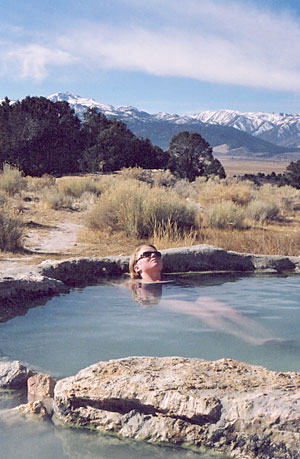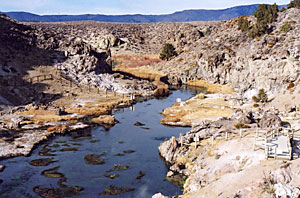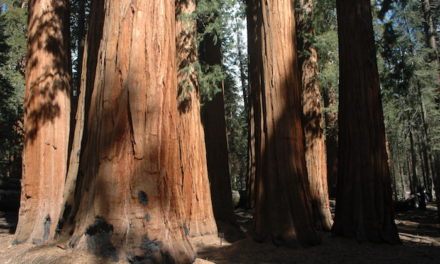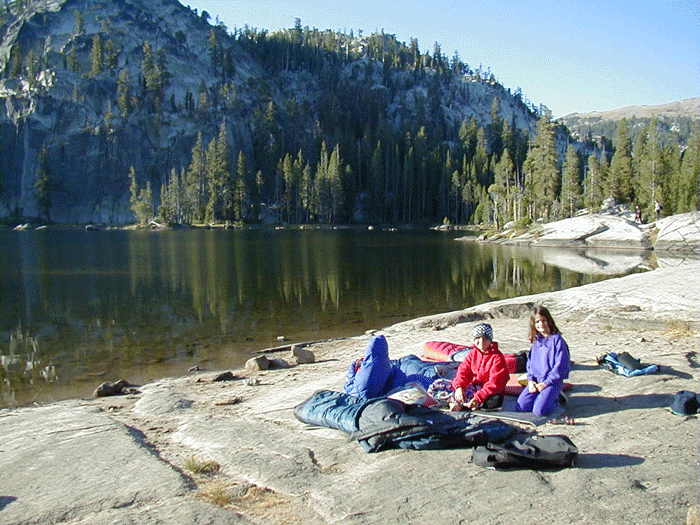- Tahoe’s Nevada Beach Tops the List of Hard-to-Book Campgrounds - 07/17/2024
- Cannabis Watershed Protection Program Cleans Up Illegal Grow Sites - 07/10/2024
- French Fire - 07/05/2024
East Side Hot Springs Nirvana for Winter Adventurers
Story and photos by Clay Breitweiser
 The headlights of my vehicle dance on the horizon. I crack a window to breathe in the cold sage-scented air. As I bounce along the washboard road, I wonder what it is I enjoy more? Getting completely lost in a maze of backroads? Or finding what I’m looking for – that bubbling pot of liquid nirvana at the end of a dusty road.
The headlights of my vehicle dance on the horizon. I crack a window to breathe in the cold sage-scented air. As I bounce along the washboard road, I wonder what it is I enjoy more? Getting completely lost in a maze of backroads? Or finding what I’m looking for – that bubbling pot of liquid nirvana at the end of a dusty road.
Well, it would have to be the latter, but the former makes it all that much better.
Whether you go just for the hot springs, or you’re a road-tripping skier or climber in need of a soothing bath under a ceiling of ten-thousand stars, you’re unlikely to find a greater abundance of soakable hot pools in a more spectacular setting than the Owens Valley region.
Sheltered by the ultra-absorbent precip curtain that is the High Sierra, winter is a magical time to visit. The peaks and canyons may be choked with snow, but most of the hot springs remain accessible after all but the nastiest storms.
From Bridgeport to Bishop, the region is easily traveled via Highway 395, as awe-inspiring a strip of asphalt as any mountain freak could ever hope to travel. While the Eastern Sierra manifests itself as a serrated wall jutting 7,000 to 10,000 feet above the valley on the west, the high-and-dry White Mountains and other Great Basin ranges arrest your view to the east. A mile above sea level, the clear, thin air makes for heavenly star gazing. Meteors and satellites seemingly collide.
East Side veterans know there’s no better place to relive a day of backcountry skiing, ice climbing or other winter adventure than a hot pool with friends, and maybe a few others.
Around Bridgeport
Right off 395 just past the stoplight-free town of Bridgeport, Travertine Hot Springs are perhaps the most convenient springs for winter travelers. They can be reached by making the long haul from the Bay Area or elsewhere in Northern California, via Carson Pass (Highway 88), the most southerly winter-crossing route, or Highways 50 or 80. Named after the unique mineral formations found here, Travertine has several rustic pools and a nice concrete one. Although no camping is allowed at the springs, you can drive right to them at any time of the night or day and rest your weary bones. You can find camping nearby, making for an easy morning soak.

From Bridgeport though, it’s a short drive to Twin Lakes, the launching point for incredible backcountry skiing and boarding along the Sawtooth Ridge. Several jagged peaks in the range of 12,000 feet form the northeast boundary of Yosemite National Park. Open bowls and technical lines abound. Bring your mountaineering skills and your avalanche savvy, for this is not an area for greenhorns. The highest point along the ridge is Matterhorn Peak, (12,279’) a striking spire with expert terrain, including the East Couloir. The resort at Twin Lakes is closed during the winter. Although frigid, good camping can be found for well-equipped, hot-blooded adventurers around Horse Creek at 9,300 feet.
A couple thousand feet lower in elevation, and a few miles down a bumpy dirt road, you’ll find Buckeye Hot Springs. Located near Buckeye Campground, this series of pools is fed by a hot waterfall. The adjacent icy stream provides a wonderful cold plunge for polar-bear types.
Around Mammoth
Further south, about 15 miles below Mono Lake, is the Long Valley Caldera, the primary boiler plate for hot springs in this region. Formed some 760,000 years ago by a volcanic eruption, this geothermal hot spot located just to the southeast of the town/raging SoCal winter playground of Mammoth Lakes (which, actually, latitude-wise, I must note, is clearly in NorCal), contains a dozen or so hot springs all within a few miles of one another. These include springs like Hilltop, Crab Cooker, Crowley and Little Hot Creek.
More evidence of the Long Valley Caldera’s thermal vitality can be witnessed at the Hot Creek Geological Site. With a flow rate of 250 liters per second, Hot Creek is the largest hot spring in the western United States. The site is like a miniature Yellowstone, with geysers, fumeroles, and several springs. But be forewarned just taking a dip in these waters could send you to that great hot spring in the sky. Not only are there high levels of arsenic found in these waters, but at 200 degrees Fahrenheit the water can cause serious burns. These boiling or near-boiling springs are mostly roped off. Most bathers head for the spring that emerges in the middle of the creek, making an electrifying full-commitment swim through cold water necessary before you feel the heat. Neophytes will be understandably skeptical. Camping can be found a short ways away in the Toiyabe National Forest.
A little further south, near Benton Crossing, lie several hot springs, one of the more popular of which is Crowley Hot Springs. A scenic rock-lined pool and perfect water temps, draw hot spring aficionados from near and far. It’s not uncommon to find a party scene here at night during the ski season. Luckily, automobiles are not allowed past a certain point, so vehicle noise is kept to a minimum. A smaller, less-developed pool nearby offers a more intimate setting.
For soakers looking for all-you-can-handle lift-served vertical, Mammoth Mountain offers destination-worthy big-mountain skiing and boarding. And don’t forget often-overlooked June Mountain, which has a less Disneyesque atmosphere (no parking-lot monorail), some of the most Utah-like flakes a California powderhound could wish for, and spectacular views of Mono Lake and the lonesome Great Basin lands stretching east.
During warmer months, there are multiple other ways to earn your soak. The mountain biking in the area is renowned. Climbers can spider up hundreds of sport routes in the Owens River Gorge, attempt to stick to boulders in the Buttermilks, or test their trad mettle on soaring Sierra granite. Other popular favorites include hiking, backpacking, trail running, fly fishing, and that most egalitarian of activities, wide-eyed wandering.
 Don’t Be a Pool Fool
Don’t Be a Pool Fool
I’ve mentioned only a few of the many wonderful hot springs in this area. Some savvy research and exploration is usually all it takes to find these and others.
All who visit need to be noble ambassadors to ensure future access and enjoyment. Use common sense and follow low-impact etiquette. This means packing out all of your own trash and sometimes other’s, too; respecting private property; not getting belligerent and making a fool of yourself; keeping noise levels down. Remember, most visitors consider these places sacred and are there in search of peace and relaxation. And be aware that not all hot springs are clothing optional; follow local customs and consider the circumstances before skinny dipping.
With my gas tank and patience getting low, I am almost to the point of abandoning my search, when suddenly my headlights illuminate a wisp of steam. Bingo. I kill the engine, and step out into the frigid night. As I slip out of my clothes and into my birthday suit, I settle into that ahhh-inducing, skin-tingling warmth. My worries melt away as I turn to my traveling companion and say, as I’ve said many times before, “This is the stuff dreams are made of.”













